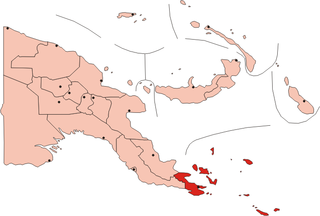
The prehistory of Papua New Guinea can be traced to about 60,000 years ago, when people first migrated towards the Australian continent. The written history began when European navigators first sighted New Guinea in the early part of the 16th century.

The Louisiade Archipelago is a string of ten larger volcanic islands frequently fringed by coral reefs, and 90 smaller coral islands in Papua New Guinea.

West Papua is a province of Indonesia. It covers the two western peninsulas of the island of New Guinea along with nearby islands. The province is bordered to the north by the Pacific Ocean, to the west by the Halmahera Sea and the Ceram Sea, to the south by the Banda Sea, and to the east by the province of Papua and the Cenderawasih Bay. Manokwari is the capital, while Sorong is the largest city and the main gateway to the province. According to the 2010 census by Statistics Indonesia, West Papua recorded a population of 760,422. Inaugurated as a province in 2003, West Papua was initially named West Irian Jaya until 2007. The name West Papua itself is also used by the Free Papua Movement to refer the whole Western New Guinea. Consisting of twelve regencies and one city, the province enjoys a special autonomous status as granted by the Indonesian legislation. West Papua is well known by its Raja Ampat Islands which contains the richest marine biodiversity in the world.

The Territory of Papua comprised the southeastern quarter of the island of New Guinea from 1883 to 1975. In 1883, the Government of Queensland annexed this territory for the British Empire. The United Kingdom Government refused to ratify the annexation but in 1884 a Protectorate was proclaimed over the territory, then called "British New Guinea". There is a certain ambiguity about the exact date on which the entire territory was annexed by the British. The Papua Act 1905 recites that this happened "on or about" 4 September 1888. On 18 March 1902, the Territory was placed under the authority of the Commonwealth of Australia. Resolutions of acceptance were passed by the Commonwealth Parliament, who accepted the territory under the name of Papua.
PNG Air is an airline based on the grounds of Jacksons International Airport, Port Moresby, Papua New Guinea. It operates scheduled domestic and international flights, as well as contract corporate charter work. Its main base is Jacksons International Airport.

Samarai is an island and former administrative capital in Milne Bay Province, Papua New Guinea.

Jacksons International Airport, also known as Port Moresby Airport, is located 8 kilometres outside Port Moresby, in Papua New Guinea. It is the largest and busiest airport in Papua New Guinea, with an estimate of 1.4 million passengers using the airport by 2015, and is the main hub for Air Niugini, as well as the main hub for PNG Air and Travel Air. It replaced the original Port Moresby airport, in what is now the suburb of Waigani, whose airstrip remained until the 1990s but no trace of which is now there, it having been built over.

The Anglican Church of Papua New Guinea is a province of the Anglican Communion. It was created in 1976 when the Province of Papua New Guinea became independent from the Province of Queensland in the Church of England in Australia following Papua New Guinea's independence in 1975.

The Dart Reefs is a group of reefs in the central area of the Ward Hunt Strait in Milne Bay Province of southeastern Papua New Guinea.

Sideia Island is an island in the Louisiade Archipelago in Milne Bay Province, Papua New Guinea.

Basilaki Island is an island in the Louisiade Archipelago in Milne Bay Province, Papua New Guinea. It is located at the eastern end of the New Guinea mainland.

The Panniet naked-backed fruit bat, also known as the De Vis's Bare-backed Fruit Bat and Panaeati Bare-backed Fruit Bat, is a species of megabat in the family Pteropodidae.
Sport in Papua New Guinea is an important part of the national culture. Rugby league is the most popular sport in Papua New Guinea.

New Guinea is a large island separated by a shallow sea from the rest of the Australian continent. It is the world's second-largest, after Greenland, covering a land area of 785,753 km2 (303,381 sq mi), and the largest wholly or partly within the Southern Hemisphere and Oceania.
Papua New Guinean literature is diverse. The emergence of written literature is comparatively recent in Papua New Guinea. It was given its first major stimulus with the setting up of creative writing courses by Ulli Beier at the University of Papua New Guinea. Beier also founded a Papua Pocket Poets series, as well as the literary magazine Kovave, the first of its kind in the country. Some of Papua New Guinea's first noted writers, including John Kasaipwalova, Kumalau Tawali, Apisai Enos and Kama Kerpi, were first published in Kovave.
Afawa Cave is a karst cave located in Doe, Central Province, Papua New Guinea. It is very remote; the most common way to access the cave is by an 80 km, two-day trek. From Doe, it is a one-hour steep climb to reach the altitudinous cave, which is home to a large colony of flying foxes
Diu Diu Cave is a karst cave located in Waigani, Milne Bay Province, Papua New Guinea. Traversing through the cave is very difficult; it involves wading through mud and guano with a low ceiling that at times dips to a mere 80cm clearance. The cave is home to a population of blind cave eel, cave prawn, cave spiders, and various species of bats, including flying foxes.

Nubara is island in Papua New Guinea. It is located in the east of the country, in the Milne Bay Province, about 700 km to the east of the Port Moresby.











